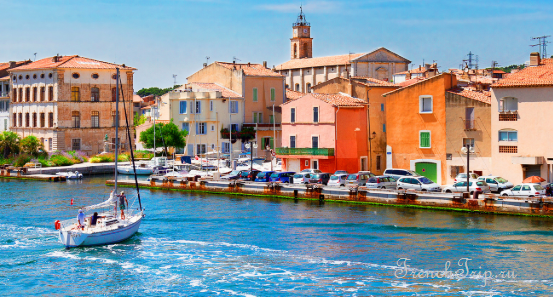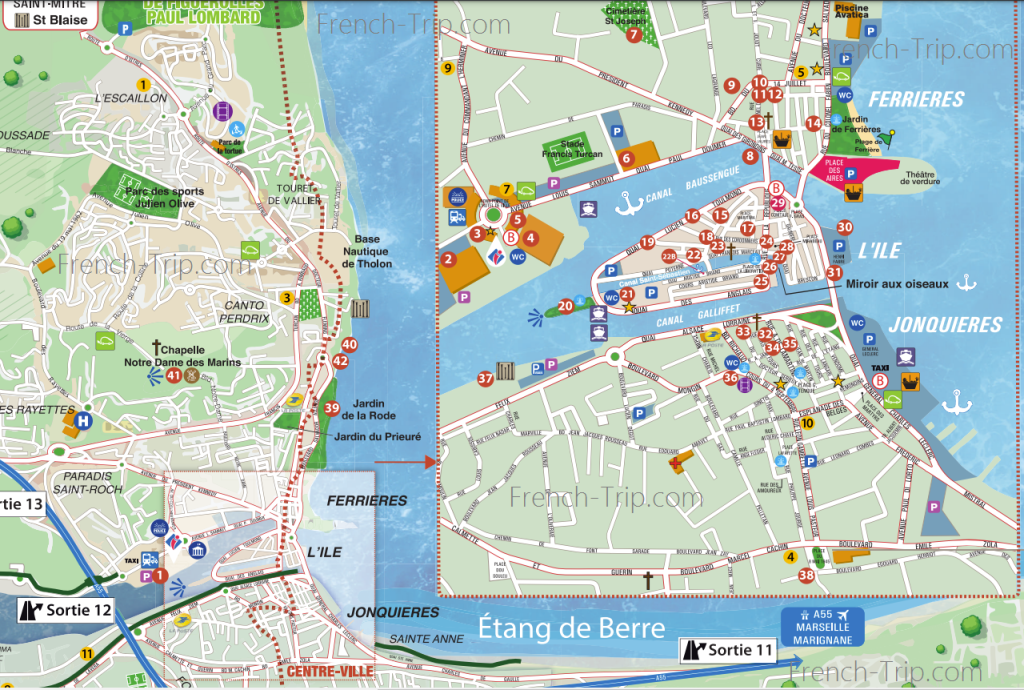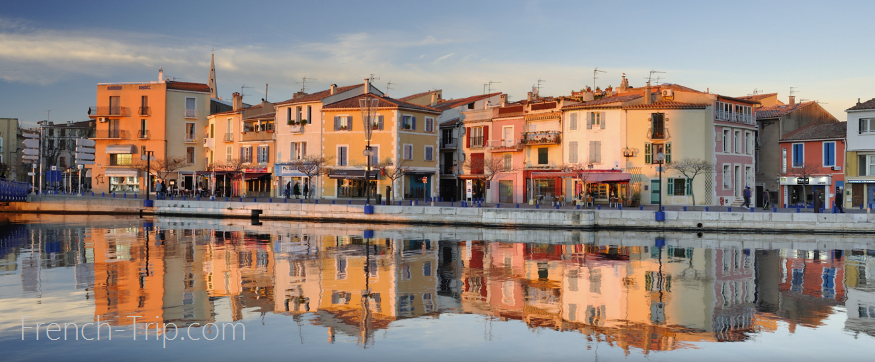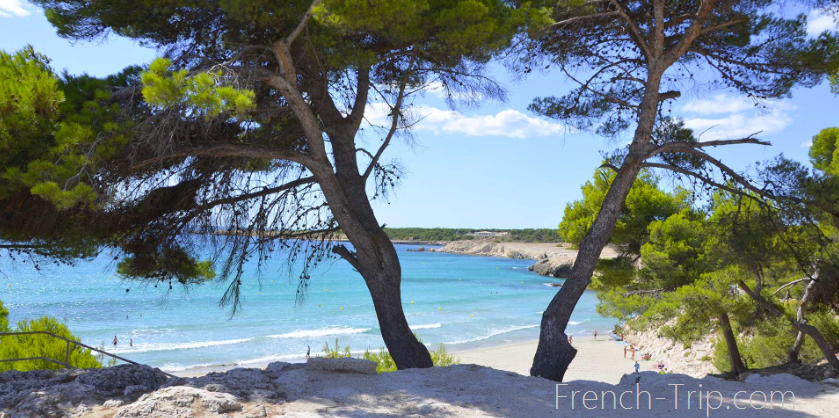Martigues
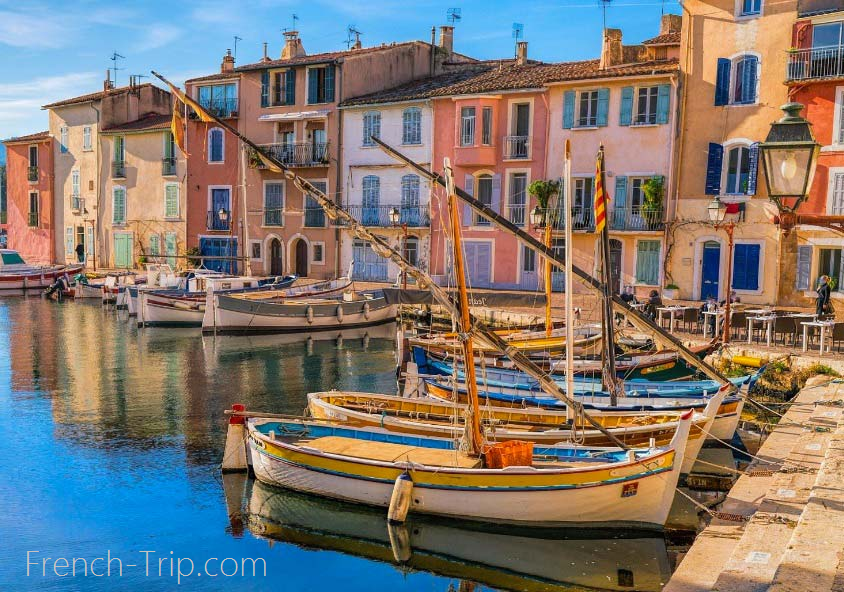
Martigues is a town located in the Bouches-du-Rhône department in the Provence-Alpes-Côte d’Azur region of southern France. It is known as the “Venice of Provence” due to its picturesque canals and waterways that wind through the town. Martigues is situated on the Mediterranean coast and offers a charming blend of historic architecture, natural beauty, and a lively cultural scene.
The town is divided into three main districts: Jonquières, L’Île (the island), and Ferrières. Visitors to Martigues can explore its historic Old Town, stroll along the canals, and enjoy the Mediterranean climate. The town also hosts various festivals and events throughout the year, celebrating its cultural heritage and maritime traditions.
Martigues is a popular destination for tourists looking to experience the beauty of Provence and the Mediterranean coast while enjoying a vibrant and welcoming atmosphere. Martigues can serve as a convenient base for excursions to Marseille (40 km), Aix-en-Provence (46 km), Arles (53 km), and Avignon (90 km).
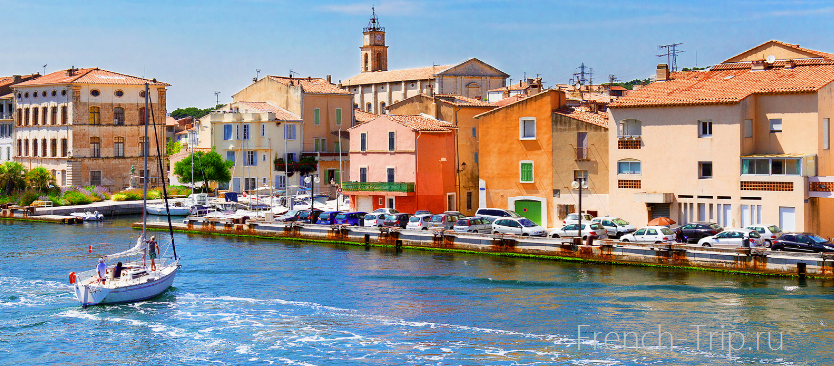
Travel Guide to Martigues
Martigues, often referred to as the “Venice of Provence,” is a charming town in the Provence-Alpes-Côte d’Azur region of southern France. This picturesque destination is known for its network of canals, historic architecture, and vibrant cultural scene.
In the western part of the more famous French Riviera (with the most popular resorts lying to the east of Marseille and along the coast towards Italy), Martigues, known as the “City of Art and History,” boasts several industrial areas on its outskirts, including an extensive oil refinery. However, the Old Town and the port area are truly charming.
Here’s a detailed travel guide to help you plan your visit to Martigues:
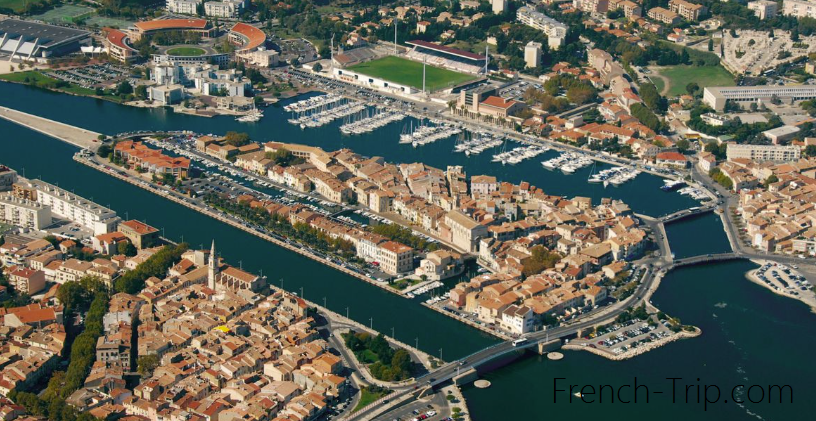
Overview
With its typical southern French penchant for exaggeration, cabaret singer Vincent Scotto once described Martigues as the “Venice of Provence,” a city whose numerous canals and enchanting light have endlessly captivated both artists and filmmakers. Nestled between the Étang de Berre and the “Blue Coast,” the city boasts a tranquil way of life on its colorful narrow streets, which create a stunning contrast with the large industrial complexes on the horizon.
Martigues was founded by Ramon Berenguer IV, Count of Provence, in 1232 at the likely site of the Roman camp Maritima Avaticorum.
Every summer, Provencal wrestling competitions take place on the canals. Since 1989, from July to August, the “Martigues Festival: Dances, Music, and Voices of the World” has been held. On June 27th, the Feast of Saint Peter (the patron saint of fishermen) is celebrated. Throughout the day, various events and festivities take place, including celebrations on the Etang de Berre.
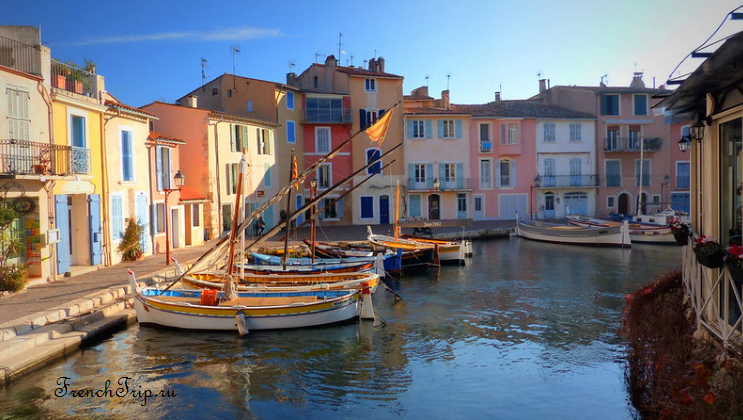
Why Visit Martigues:
- Canal Network: Explore the enchanting canals that wind through Martigues, giving it the nickname “Venice of Provence.” Take leisurely walks along the waterways and enjoy the romantic atmosphere.
- Scenic Beauty: Martigues is surrounded by stunning natural beauty. You can visit beautiful beaches along the Mediterranean coast and admire the local flora and fauna in nearby nature reserves.
- Historic Charm: Discover the historic Old Town with its narrow streets, colorful houses, and charming squares. The town is rich in history, and you’ll find interesting architecture at every turn.
- Cultural Events: Martigues hosts various cultural events throughout the year, including festivals, concerts, and art exhibitions. Check the local calendar for events during your visit.
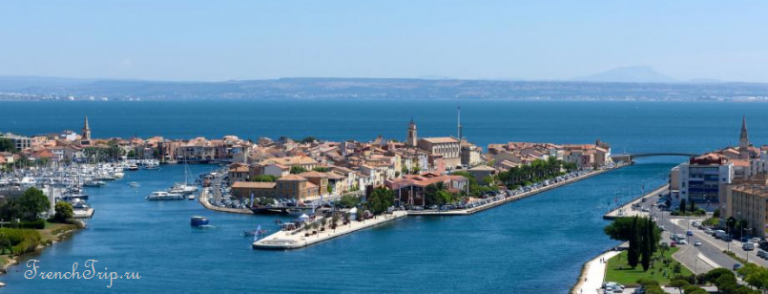
How to Get In:
- By Air: The nearest major airport is Marseille Provence Airport (MRS), approximately 40 kilometers away. From there, you can rent a car or take public transportation to Martigues.
- By Train: town has a train station, Gare de Martigues, with regular connections to Marseille, Avignon, and other cities in the region.
- TER Provence map
- Train Avignon Ville – Martigues: with change at Miramas, ~ 1:20, 19.70 €
- Train Miramas – Martigues: direct, 32 min, 7.40 €
- Train Marseille – Martigues: direct, 53 min, 9.70 €
- By Car: town is accessible by car via the A55 highway from Marseille. It’s well-connected to the road network, making it easy to reach from other parts of Provence.
- By Boat: CroisiEurope organizes river cruises between Martigues (the dock near Avenue Louis Sammut, behind the city hall) and either Lyon or Chalon-sur-Saen.
- free travel between the three Martigues districts by boat shuttle and bus line no. 20.
History of Martigue:
- Ancient Times: The area where Martigues is located today has been inhabited since ancient times. It was originally settled by the Ligurians, and later, it became a significant Roman outpost known as “Maritima Avaticorum.” During this period, the Romans built canals and fortifications in the area, making use of its strategic location between the Mediterranean Sea and the Étang de Berre.
- Medieval Era: In the 13th century, Ramon Berenguer IV, the Count of Provence, founded the town of Martigues in 1232. He constructed a castle and fortified the settlement to protect it from raids and invasions.
- Renaissance and Growth: Martigues continued to develop during the Renaissance. The town’s canals, which have earned it the nickname “Venice of Provence,” were further expanded during this period, facilitating trade and transportation.
- Industrialization: In the 19th century, Martigues experienced industrial growth, especially with the establishment of a major oil refinery in the area. This industrialization brought economic prosperity to the town but also altered its landscape.
- World Wars: Martigues, like many other European cities, was affected by both World War I and World War II. The town played a role in the resistance against the Axis powers during World War II.
- Post-War Period: After World War II, Martigues underwent further development and modernization. It continued to be an important industrial and commercial center in the region.
- Contemporary Martigues: Today, Martigues is known for its charming canals, historic architecture, and cultural heritage. It has diversified its economy beyond heavy industry and has become a destination for tourists interested in exploring the picturesque Old Town, enjoying local festivals, and experiencing the natural beauty of the surrounding region, including the Étang de Berre.
Overall, Martigues has a multifaceted history that reflects its evolution from ancient Roman origins to a modern Mediterranean town with a unique character and identity.
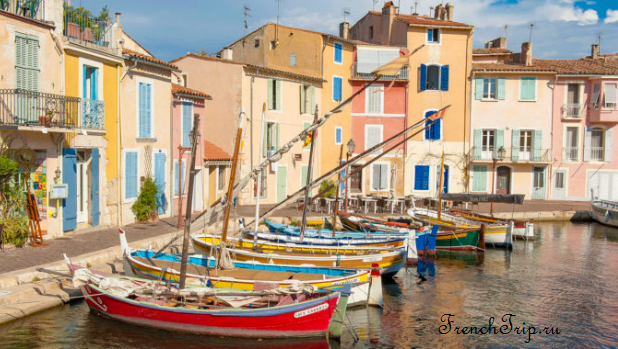
Explore Martigues:
Martigues’ Old Town is essentially divided into three parts by canals that connect the Étang de Berre to the ocean. Because of these canals, Martigues is often referred to as the Provencal Venice. The Martigues region known as l’Ile is the most picturesque (an island formed by canals on both sides), while the sector called Jonquieres (to the south of l’Ile) is also worth exploring, as it is home to numerous shops and boutiques.
The bustling harbor around the Brescon embankment and along the Saint-Sebastien Canal is of particular interest to visitors. It is surrounded by attractive pastel-toned 17th-century fishermen’s houses. While your visit will mainly focus on strolling through the streets and along the canal and spending time in boutiques and cafes, there are also some interesting places to see. In the center of l’Ile, you can find the 17th-century Eglise de la Madeleine. This church is best known for its decorative Baroque facade.
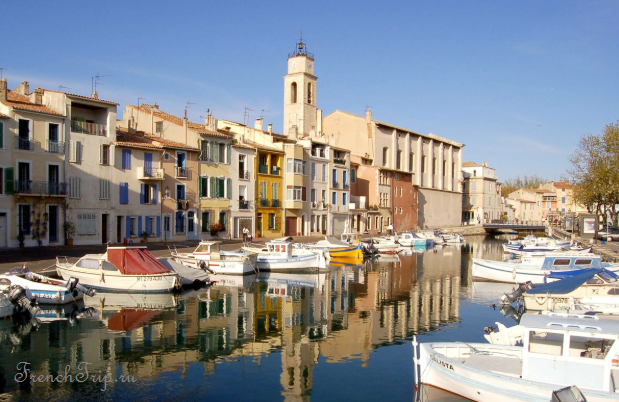
Not far from the center is the Chapel of Notre-Dame-de-Marin, a picturesque 17th-century chapel perched on a hill with an impressive view of the Étang de Berre.
Just across the canal from l’Ile in Jonquieres, you can see the Church of Saint Genes, but the small Baroque-style chapel next to the church called Chapelle de l’Annonciade (17th century) is more interesting, with a beautifully decorated interior including painted walls and ceilings and a golden altar.
Many houses have picturesque facades along the embankments and on the island. Particularly noteworthy is the Maison en Chapeau de Gendarme along the Saint-Sebastien Canal.
Main Attractions:
- Fort de Bouc: This historic fort is located at the entrance to the port of Martigues. It was originally constructed in the 17th century under the order of Louis XIV to defend the town from maritime threats. The fort offers panoramic views of Martigues, the surrounding waterways, and the Mediterranean Sea. While the fort is not always open to the public, it’s an impressive sight to behold from the outside and a testament to Martigues’ maritime history.
- Eglise Sainte-Marie-Madeleine: This church, dedicated to Saint Mary Magdalene, is an important religious and architectural landmark in Martigues. Its construction dates back to the 17th century. The church features a beautiful baroque facade with pink and blue accents, a prominent clock, and intricate stonework. Inside, you can admire the religious art and ornate decor that reflect the town’s historical significance.
- Old Town (Vieille Ville): Explore the heart of Martigues by wandering through its charming Old Town. The narrow streets are lined with colorful Provençal houses, flower-adorned windowsills, and bustling squares. The Old Town is steeped in history, and you’ll encounter picturesque corners at every turn, making it perfect for leisurely strolls and capturing the essence of the town’s past.
- The Canals: Martigues’ network of canals is the town’s defining feature. These waterways crisscross the town, creating a unique and romantic atmosphere. As you walk along the canalsides of Quai Brescon and Quai des Anglais, you’ll witness the harmony of water, architecture, and daily life. Consider taking a boat tour to appreciate the canals from a different perspective.
- Château de Ponteau: Although only partial ruins remain of the 16th-century Castle, it’s worth exploring. The castle was once a symbol of power in the region. Today, visitors can admire its historic remnants and enjoy scenic views of the surrounding area from its location atop a hill.
- La Couronne and La Saulce Beaches: Enjoy the Mediterranean coastline at the nearby beaches of La Couronne and La Saulce. These sandy shores offer opportunities for swimming, sunbathing, and water sports. La Couronne is known for its picturesque fishing village, while La Saulce provides a quieter, more natural setting.
Martigues’ attractions combine historical significance with natural beauty, creating a town that appeals to both history enthusiasts and those seeking a picturesque coastal getaway. As you explore Martigues, you’ll uncover layers of history that have shaped this charming town into the vibrant destination it is today.
Martigues Map
The part of the town, known as l’Ile, is the most picturesque (an island formed by canals on both sides), while the sector called Jonquieres (south of l’Ile) is also worth exploring, as it is home to numerous shops and boutiques.
On map you can find under numbers for each attractions of the town. More details: Martigues attractions on map
Walking Tour:
Embark on an enriching journey through the picturesque city of Martigues, affectionately known as the “Venice of Provence.” As you explore this historic gem, you’ll uncover a tapestry of art, history, and natural beauty that define its unique character. Begin your adventure with a panoramic view from Chapelle Notre Dame des Marins, which offers a 360° perspective of the city nestled amid waterways, canals, and bridges. Dive into the city’s captivating narrative, from its three distinct districts— Ile, Jonquières, and Ferrières—to renowned museums, centuries-old churches, and remarkable landmarks. Read more…
Martigues Beaches
While in Martigues, you will inevitably want to visit the beach to enjoy the sea and sun. Martigues beaches are located along the coastline not far from the city. Plage de la Saulce and Plage du Verdon are the main beaches, and there are several others nearby, including a nudist beach. Most of the beaches here are sandy, although a couple of them are a mixture of sand and pebbles. Read more…
To eat
In the city, you can savor many fish-based dishes, such as the hearty fish soup bouillabaisse or a dish called bourride.
Martigues’ most famous signature dish is “bottarga” (poutargue), also known as “Martégal Caviar.” It is the dried and salted roe of grey mullet. Bottarga, like caviar, has become a sought-after and expensive delicacy. Currently, grey mullet is falling victim to overfishing, making bottarga a luxury item. In France, this luxurious dish is a signature of the city of Martigues, and Martigues’ bottarga is referred to as “Martigues caviar.”
A female grey mullet weighing one kilogram produces 150 grams of eggs, which yield 120 grams of bottarga when prepared. Production is around 50 kilograms per year.

Pieces of bottarga are covered in wax. This serves a dual purpose: to stop their ripening at the right moment and to preserve and protect the roe from any external contact.
To consume bottarga, it needs to be thinly sliced, removing the wax protection, and optionally, cleaning it by removing the thin membrane that forms a pouch around the roe. Bottarga is eaten in thin slices or grated on dishes like pasta or toast with olive oil.
Such a delicacy comes at a relatively high price, around €90 per kilogram.
Wines of Martigues
The Coteaux d’Aix-en-Provence AOC wines, La Venise Provençale, have been produced by the Saint-Julien-les-Martigues cooperative since 1986. This part of the AOC vineyards (250 hectares) is the closest to the sea.

What’s Around:
Martigues’ strategic location allows for easy day trips to other attractions in the Provence region. Consider visiting the Alpilles, Camargue, Vaucluse, Luberon, or the Calanques of Marseille and Cassis, all within a short drive.
In the vicinity of Martigues, there are also several significant Roman ruins and archaeological excavations. You can inquire at the Tourist Office for brochures that offer guided walks around the city and its surroundings, highlighting all the most important sites.
The coastline is undoubtedly the most popular attraction, and you can enjoy exploring the coastline around Martigues, with its calanques (white cliffs in the sea), small beaches, and coastal villages. Sooner or later, when you head to Marseille, you’ll reach Carry-le-Rouet, a seaside town located to the southeast of Martigues.
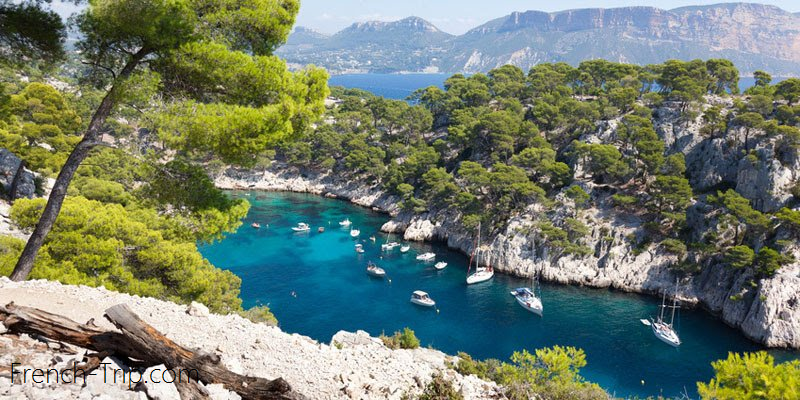
Martigues on map:
Archives
Calendar
| M | T | W | T | F | S | S |
|---|---|---|---|---|---|---|
| 1 | 2 | 3 | 4 | 5 | 6 | 7 |
| 8 | 9 | 10 | 11 | 12 | 13 | 14 |
| 15 | 16 | 17 | 18 | 19 | 20 | 21 |
| 22 | 23 | 24 | 25 | 26 | 27 | 28 |
| 29 | 30 | |||||
